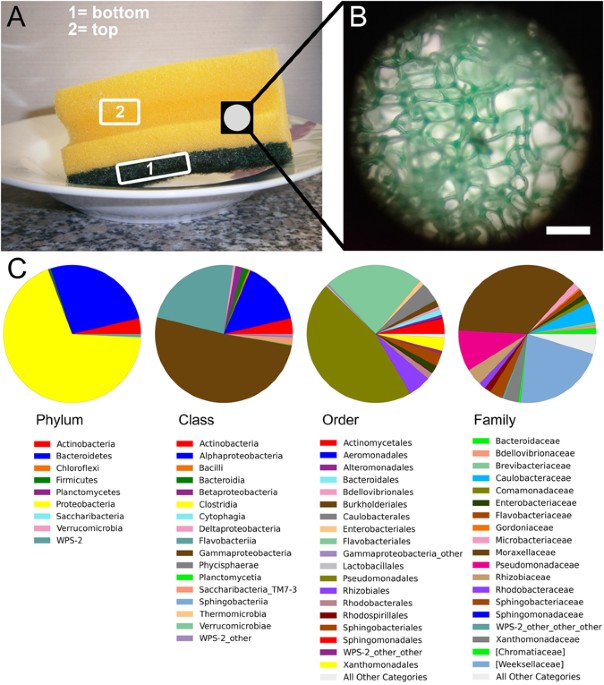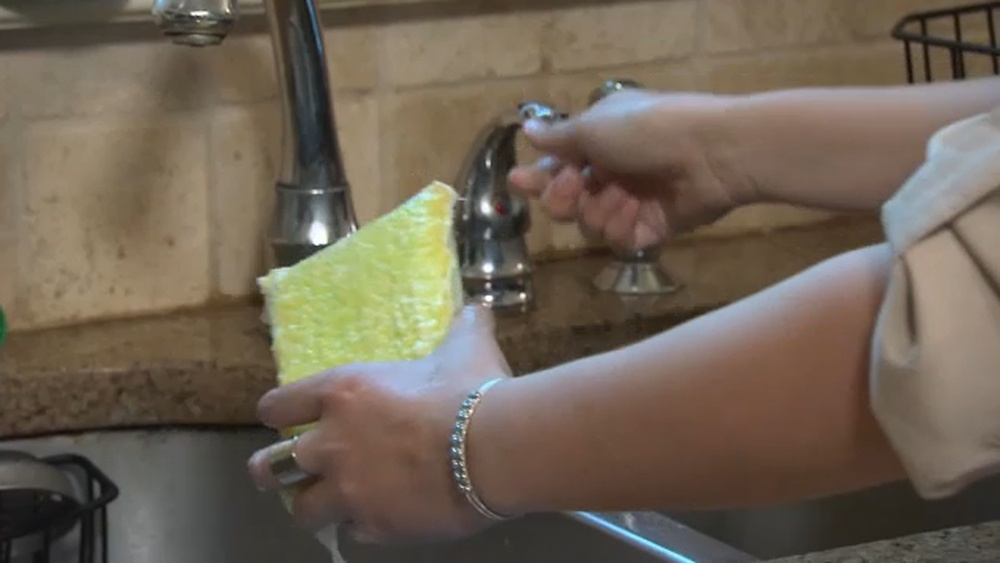Have you ever wondered why some kitchen sponges seem to get smelly and dirty faster than others? It’s not just about how often you use or clean them.
The truth is, certain sponges create the perfect hiding spots for bacteria, while others resist germs better. If you want to keep your kitchen cleaner and protect your health, understanding why some sponges harbor more bacteria than others is key.
You’ll discover what makes some sponges a breeding ground for harmful microbes and learn which sponge types can help you avoid those unwanted guests. Keep reading to find out how to make smarter choices for your home and your family’s safety.

Credit: www.pnas.org
Bacteria In Sponges
Sponges often carry bacteria, but not all sponges hold the same amount. Some sponges create a perfect home for bacteria. Others stay relatively clean. Understanding why helps us choose better sponges and keep our kitchens safer.
Bacteria live on sponges because sponges provide moisture and food. These conditions help bacteria grow and multiply quickly. The type and amount of bacteria depend on the sponge’s material and environment.
Why Sponges Attract Bacteria
Sponges attract bacteria because they are wet and porous. Water stays inside the tiny holes, creating a moist place for bacteria to thrive. Food particles trapped in sponges feed the bacteria.
Warmth from room temperature also helps bacteria grow faster. The sponge’s soft texture makes it easy for bacteria to cling and hide. This is why kitchen sponges often have more bacteria than other cleaning tools.
Common Bacteria Found In Sponges
Many types of bacteria live in sponges. Some common ones include E. coli, Salmonella, and Staphylococcus. These bacteria can cause illness if they spread to food or surfaces.
Other bacteria found are harmless and naturally occur in the environment. Yet, harmful bacteria multiply quickly in dirty sponges. Regular cleaning and drying can reduce these bacteria and keep sponges safer to use.

Credit: www.nature.com
Material Impact On Bacteria Growth
Sponges made from different materials show varied bacteria levels. The surface type plays a key role in bacterial attachment and growth. Some materials encourage bacteria to thrive, while others resist it. Understanding these differences helps choose safer sponges.
Materials influence moisture retention, texture, and airflow. These factors affect how fast bacteria multiply. Sponges with poor drying abilities often harbor more germs. The choice between porous and non-porous surfaces matters a lot.
Porous Vs Non-porous Surfaces
Porous materials have tiny holes and spaces. These gaps trap water, food particles, and dirt easily. Bacteria find these spaces perfect for shelter and growth. Common kitchen sponges are mostly porous, making them breeding grounds for germs.
Non-porous surfaces are smooth and solid. They prevent water and debris from getting trapped. Bacteria have fewer places to hide and grow. Silicone sponges are a popular non-porous alternative. They dry quickly and clean easily.
Hydrophilic Materials And Bacteria Attachment
Hydrophilic materials attract and hold water. This moisture creates a friendly environment for bacteria. Sponges made from hydrophilic substances stay wet longer. Prolonged dampness encourages bacterial growth and bad odors.
Materials that repel water reduce bacteria attachment. Quick-drying sponges limit the time bacteria can survive. Choosing hydrophobic or treated materials helps reduce bacteria buildup. This makes cleaning safer and more effective.
Types Of Sponges And Bacteria Levels
Different sponges hold different amounts of bacteria. The type of sponge affects how many germs it can carry. Some sponges dry quickly and resist bacteria growth. Others have many tiny holes that trap moisture and germs. Choosing the right type of sponge helps reduce bacteria levels in your kitchen.
Antimicrobial Sponges
Antimicrobial sponges contain special agents that stop bacteria from growing. These sponges dry faster and stay cleaner longer. Brands like Skura Style use foam treated with antimicrobial chemicals. Forever Sponge combines materials that fight germs naturally. These sponges help keep your dishes safe and fresh.
Non-porous Silicone Sponges
Silicone sponges have a smooth, non-porous surface. This means bacteria cannot easily hide inside. They dry quickly and are easy to clean in a dishwasher. Non-porous sponges do not trap food particles or moisture. This lowers the chance of bacteria buildup over time.
Natural Loofahs And Eco-friendly Options
Natural loofahs come from plant fibers and dry fast. They resist odors and bacteria better than synthetic sponges. Eco-friendly sponges made from recycled materials offer reusable choices. These sponges reduce waste and keep kitchens cleaner. They provide a natural way to fight germs while protecting the environment.
Moisture And Environment Factors
Moisture and environment play a crucial role in how many bacteria grow on sponges. Sponges that stay wet for long periods create a perfect place for bacteria to multiply. The type of environment around the sponge also affects bacterial growth. Warmth and moisture levels often work together to increase bacteria presence. Understanding these factors can help reduce bacteria on kitchen sponges.
Role Of Warmth And Moisture
Warmth speeds up bacterial growth on sponges. Bacteria multiply faster in warm, wet conditions. A sponge left in a warm kitchen or near a heat source stays moist longer. This moisture combined with warmth creates a breeding ground for bacteria. Cooler, drier places slow down this process. Sponges in dry environments tend to have fewer bacteria.
Drying Speed And Bacteria Prevention
How fast a sponge dries affects bacteria growth. Quick drying limits the time bacteria can grow. Sponges that stay wet for hours develop more bacteria. Hanging a sponge or placing it somewhere with good airflow helps it dry faster. Materials that absorb less water also dry quicker. Choosing fast-drying sponges helps keep bacteria levels low.
Comparing Sponges And Dishcloths
Sponges and dishcloths are common kitchen tools used daily for cleaning. Both come into contact with food residues and moisture. These conditions can promote bacteria growth. Understanding how bacteria levels differ between sponges and dishcloths helps maintain a cleaner kitchen.
Bacteria Levels In Each
Sponges have many small holes that trap food particles and moisture. This creates a perfect environment for bacteria to grow rapidly. Dishcloths, made from woven fabric, absorb water but dry faster than sponges. Faster drying limits bacteria growth. Studies show sponges tend to hold more bacteria than dishcloths after use.
Which Harbors More Germs?
Sponges harbor more germs due to their porous structure. The trapped moisture and food bits feed bacteria. Dishcloths, when washed regularly, reduce bacterial buildup. Using antimicrobial or quick-drying materials also helps lower germs in both tools. Choosing the right cleaning tool impacts kitchen hygiene significantly.

Credit: med.ucf.edu
Best Sponges To Avoid Bacteria
Choosing the right sponge can reduce bacteria growth in your kitchen. Some sponges trap germs easily, while others resist them well. Using sponges made from specific materials helps keep your cleaning tools safer and cleaner. Below are the best sponge types and brands to avoid bacteria.
Materials To Choose
Non-porous materials stop bacteria from hiding inside. Silicone sponges are popular because they dry quickly and do not absorb water. This reduces the chance for germs to grow. Natural loofahs are another option. They dry fast and have natural antibacterial properties. Swedish dishcloths also work well. They dry quickly and can be washed multiple times. Sponges with antimicrobial treatments block bacteria from growing on their surface. Choosing these materials helps keep your sponge cleaner and safer.
Recommended Brands And Products
Skura Style sponges use special foam treated with an antimicrobial agent. This stops odors and bacteria from forming. They dry fast, which lowers germ growth. Forever Sponge combines three antimicrobial materials to fight germs effectively. Silicone sponges can be cleaned in the dishwasher, making them easy to maintain. Swedish dishcloths are affordable, reusable, and quick-drying. Natural loofahs offer a biodegradable and antibacterial choice. These brands and types help you avoid bacteria in your kitchen sponges.
Maintenance Tips To Reduce Bacteria
Sponges can hold many bacteria if not cared for properly. Keeping them clean and dry helps reduce germs. Proper maintenance keeps your sponge safer to use. Follow simple tips to lower bacteria growth.
Cleaning Techniques
Rinse sponges well after each use to remove food particles. Squeeze out excess water to speed up drying. Use hot water and soap to wash sponges regularly. Microwaving damp sponges for one minute kills many germs. Replace sponges every two weeks for best hygiene.
Storage Practices
Store sponges in a dry, open area to avoid moisture build-up. Avoid leaving sponges inside the sink or under standing water. Use a sponge holder with good airflow to help them dry fast. Keep sponges away from direct sunlight, which can weaken material. Dry sponges between uses to slow bacterial growth.
Frequently Asked Questions
What Is The Best Sponge To Avoid Bacteria?
The best sponges to avoid bacteria are non-porous, antimicrobial, and quick-drying types like silicone, Skura Style foam, and Swedish dishcloths. These materials inhibit bacterial growth and dry fast, reducing germs effectively. Natural loofahs also resist bacteria due to their quick-drying, odor-free nature.
Why Do Certain Surfaces Have More Bacterial Growth Than Others?
Certain surfaces have more bacterial growth due to moisture, warmth, porosity, and nutrient availability. Rough, porous materials trap bacteria easily. Smooth, dry, non-porous surfaces limit bacterial attachment and growth, reducing contamination risks.
Can Sponges Harbor Bacteria?
Sponges often harbor bacteria due to their warmth, moisture, and food residue. They can contain harmful bacteria like E. coli and Salmonella. Regular cleaning and using antimicrobial or quick-drying sponges reduce bacterial growth and keep sponges safer for use.
What Holds More Bacteria, A Sponge Or A Dishcloth?
Sponges generally hold more bacteria than dishcloths due to their porous structure and moisture retention. Dishcloths dry faster, reducing bacterial growth.
Conclusion
Some sponges hold more bacteria because of their material and texture. Porous sponges trap moisture and germs easily. Quick-drying and antimicrobial sponges reduce bacterial growth. Choosing non-porous options like silicone limits bacteria hiding spots. Regular cleaning and replacing old sponges also help keep bacteria low.
Understanding these factors keeps your kitchen safer and cleaner. Small changes in sponge choice make a big difference in hygiene.

